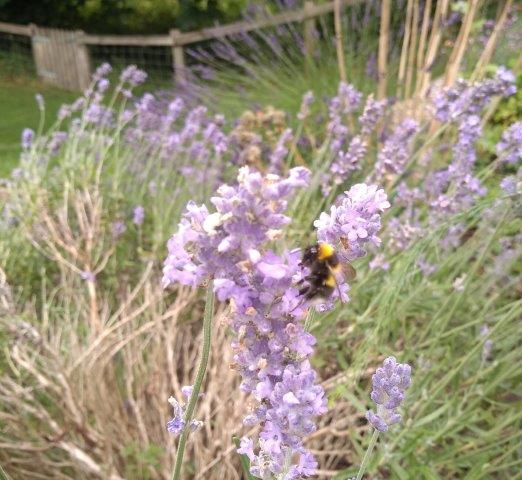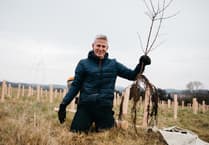At last the butterflies arrived in the second half of July. The elegant blue male Demoiselle Damselflies drifting about the stream, with occasional glimpses of the brown female, have been around since early Spring, but only the occasional butterfly has appeared in May and June.
The Cabbage, or small white butterfly, with its black tipped wings and a dot on each forewing always seems to be plentiful though, much to the detriment of my Brassicas. Must put fleece over next year! We’re told blue, purple and yellow shades of flowers are more attractive to insects and this seemed to be true, as bumblebees clambered over the fat blue thistle-like globes of Echinops and blue spikes of Veronicastrum. The mauve Buddlia was studded with half a dozen Peacocks and similar amount of Red Admirals. The welcome buzz of honey bees drew my attention to a big mauve lavender bush that sprawls over the vegetable garden wall.
In a nearby wild flower meadow, Meadow Brown and Common Blue butterflies were too numerous to count on the purple Knapweed and mauve Scabious. Beautiful little orange and brown Gatekeepers flitted around bramble flowers, two or three circling around too quick to photograph. Common blues were feeding on the tiny yellow Birds-foot trefoil, which is their host plant to lay their eggs on. Amazingly, I managed to get a photograph of a Migrant Hawker dragonfly (black wings and blue patterned abdomen) on the bramble, which are usually too quick for my camera to focus on.
Definitely too quick for me or the dog are grasshoppers creating a frenzy of movement around our feet as we walk along the path, which causes the dog to stop and stare quizzically at this mysterious activity.
We are going to attempt to increase the wild flower varieties in a section of our orchard this year. First we will have to cut and remove the long grass, then establish the parasitic Yellow Rattle to reduce the vigour of the grass and fertility of the soil further. It is not always an easy project so I will be reporting back on any success or not next year!
My plants for sale seemed to stop in their tracks mid July as the weather changed to cold and wet. Some potted Cosmos and Osteospermum look as though they will never flower, though earlier ones did well. I think I’ve used too rich a compost for the Cosmos in particular, being in the mindset of having to improve the peat-free compost to make things grow! It was probably just the right fertility, before I added loam to it!
It was time to tidy up the garden as August approached; out came the small crop of potatoes protected from the dog by sheep netting, and in went the leeks. Sprouts had been planted between the broad beans due to lack of space and have done surprisingly well. It was a bit too dry for the broad beans but we enjoyed the few meals we had out of those before they went on the compost heap. The asparagus has taken several years to establish, but did surprisingly well this year due to a liberal application of manure, or the hot weather. As observed previously the bees loved the pollen. A couple of female plants are now covered in berries for the birds. Apparently female asparagus plants are not to be encouraged as male plants produce better spears, but I shall leave them in.
The wet weather in July brought the slugs out in force again, but a copper mesh I have been using around my Dahlia stems was quite effective. I don’t use any Slug Death lest it should poison any wild life higher up the food chain, and so my husband was delighted to find a toad well camouflaged at the edge of a leafmold bin.
At last I got round to sowing Biennial seeds, wallflowers, Sweet William and Canterbury Bells. It is recommended they are sown in June, but it would have been too dry this year so hoped for success in a damp and cooler late July. Maybe we’ll have to sow more crops in the autumn if spring continues to be so dry.
The bees have been very active all season and and are now forming brood to hatch into winter bees.
These have a slower metabolism allowing a six month rather than six week life span of the summer bees, which allows them to survive through the winter until they can go out and forage again in the spring. The bees will now be left with enough honey to ensure they have enough stores to see them through the winter.
Hazel W



.jpeg?width=209&height=140&crop=209:145,smart&quality=75)

Comments
This article has no comments yet. Be the first to leave a comment.